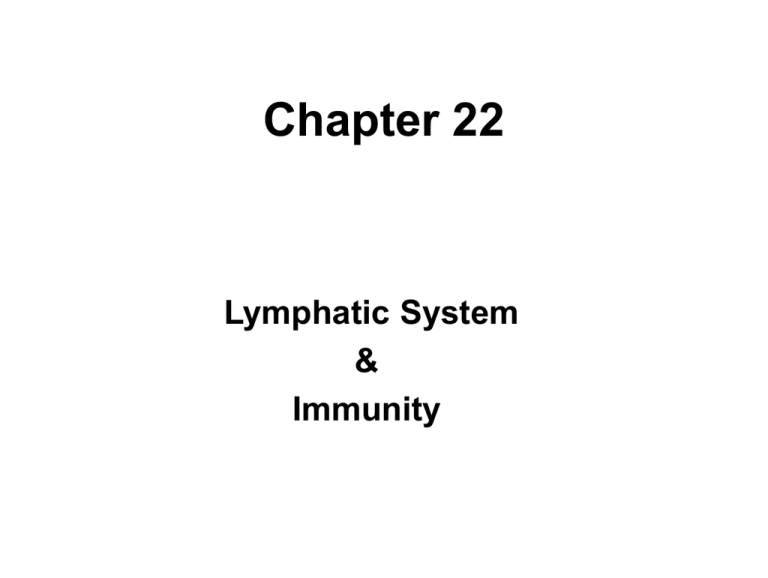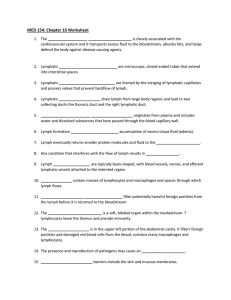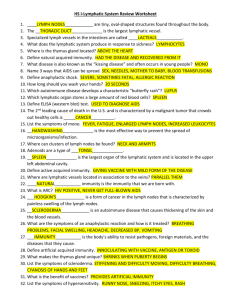Chapter 22 Lymphatic System & Immunity
advertisement

Chapter 22 Lymphatic System & Immunity Lymphatic Functions Fluid Balance – about 30L of fluid/day leaves capillaries and enters tissues – only about 27L returns to capillaries The extra fluids enters lymphatic system via the lymphatic capillaries which merge to form larger vessels Fat Absorption – Lacteals (special lymph vessels in the gut) absorb fat and other substances from digestive system. Chyle = Lymph + fat (has a milky appearance) Defense – foreign substances & organisms filtered, recognized, & attacked by lymphatic system Lymph transport of materials Low in O2 Carries waste CO2 Carries metabolic waste products Carries fat from digestive system Major Components of Lymphatic System Lymphatic vessels (capillaries & veins) Lymph nodules Lymph nodes Tonsils Spleen Thymus Major Drainage Channels Refer to material from Ch 21 Thoracic Duct drains lower limbs, abdomen, left thorax, left arm – Ultimately drains into left subclavian vein Cysterna Chyli – an expansion of the thoracic duct in the upper abdomen – so named because it receives chyle from the gut (chyle = fat laden lymph) Right Lymphatic Duct – drains right arm, right side of head, right thorax – empties into right subclavian vein. #RLD is variable 1, 2 or 3 per person Lymph Nodes – round/oval/bean shaped –scattered throughout, these act as filters in the system Lymphatic System Overview Fig 21.28 p 672 (yes, prior chapter) Fluid movement from Circulatory into Lymphatic Structure of Lymph Capillary Lymph capillaries differ from blood capillaries because they are blind-ended. Fluid enters through pseudo-pores in capillaries Pseudo-pores – overlapping (valve-like) endothelial cells Internal valves also prevent backflow of lymph Lymph flows because it is pushed from behind as more fluid enters from the interstitial spaces Lymph Nodes Bean shaped, round or oval – these filters cluster in regions like axilla, inguinal area, neck, gut Function – constantly filter lymph as it flows through these in-line filters Lymph Node Structure Externa capsule of connective tissue Trabeculae – connective tissue fibers extending from the outer capsule toward center Lymph nodules – internal divisions of the lymph node (like sections in an orange) Germinal Center – region in nodules where new lymphocytes are formed Lymph veins entering & leaving node Lymph Node fig 22.4 p705 Tonsils These are clusters of lymphatic nodules embedded in connective tissue Function – form a ‘defensive ring’ around the entrance to the pharynx Any microbes entering the body through the mouth or nose are exposed to the immune system here 3 Types include: Lingual – under tongue Palatine – at sides of upper throat Pharyngeal – between nasopharynx & oropharynx Tonsils fig 22.3 p 704 Spleen Location – upper left quadrant of abdomen Spleen is fibroelastic – it can expand/contract Fibrous capsule with trabeculae extending inward (much like a very large lymph node) Contains lymphatic nodules (“white pulp”) Contains venous sinuses (“red pulp”) which serve as a storage area for red blood cells Spleen Functions Nodules in the “white pulp” region are part of the Mononuclear Phagocytic System Disease organisms & dead RBCs are destroyed by this system “Red pulp” regions serve as a reservoir for RBCs If you’ve ever felt the ‘left side abdominal cramp’ during extended aerobic exercise (like running) you’ve felt the spleen squeezing out extra RBCs Spleen (fig 22.5 p 707) Gut Associated Lymphatic Tissues GALT – Gut Associated Lymphatic Tissue -- a diffuse network of tissue occurring in the intestines. GALT similar in structure/function to lymph nodules Peyer’s Patches- lymph nodules found in the small intestine and appendix Lacteal ducts - lymph capillaries located in the gut wall, absorb lymph from capillaries and fat from digestive system (chyle = lymph + fat milky appearance) fig 24.11(p795) Thymus Triangular bi-lobed gland around the base of the heart (remember cardiac anatomy here: the ‘base’ of the heart is at the top) Surrounded by a connective tissue capsule with trabecular fibers extending in to the interior dividing the gland into lobules Each lobule has an outer cortex & inner medulla Blood/Thymic barrier prevents substances in blood from entering thymus Thymic hormones produced here Thymus is the site where T-lymphocytes mature thymus fig 22.6 p 708 The End. 22 Lymph lymph lymph lymph lymph lymph 22 Lymph lymph lymph lymph lymph lymph "Trust your hunches... Hunches are usually based on facts filed away just below the conscious level. Warning! Do not confuse your hunches with wishful thinking. This is the road to disaster." -- Joyce Brothers,American psychologist and author Chapter 22 continues… The Lymphatic System Immune Responses Inflammatory Response Inflammation – an acute localized response (reddening) of the tissue to invading microbes. Symptoms include: Swelling – as fluids move into tissues, area swells Redness – blood vessels dilate & more blood flows to area Pain – prostaglandins (produced by mast cells) stimulate pain receptors Abscess – includes dead neutrophils, dead microorganisms, as well as pyrogens (fever promoters) Heat – raises temperature above what bacteria can tolerate – Fever is USEFUL! Events of Inflammation Blood flows to area (histamine, kinins, complemenent, & prostoglandins) permeability of blood vessels (as above) Blood viscosity … flows more slowly Slowing of blood allows clotting mechanisms to begin area walled off by fibrin clot preventing spread of invader Events of Inflammation… With viscosity WBCs begin to marginating (lining up along periphery like paving stones) Diapedesis – after margination, WBCs begin amoeboid-like movement out of vessels & into tissue WBCs marginating also release chemicals to attract other WBCs via chemotaxis Opsonins (more on this soon) mark foreign cells for destruction Inflammatory Response Chemical Mediators of Inflammation more… see Table 22.1 p 709 Histamine – a vasodilator released from Mast Cells also increases blood vessel permeability Mast Cells activated when antigen (foreign substance) is located by an antibody and the antibody is then attaches to antigen & to the mast cell. This event triggers release of histamine. Kinins – plasma polypeptides vasodilator, vessel permeability, stimulate pain receptors, chemotaxis of neutrophils Interferons – proteins that protect against viral infections & some forms of cancer - don’t protect cell, don’t destroy virus – bind to neighbors, stimulate production of anti-viral proteins which inhibit viral replication (generic protection one stops many) Complement Cascade (another chemical mediator) Approx 20 proteins – circulating in plasma in inactive form. C1-C9, Factors B,D & P (properdin) Cascade – each activates the protein next in sequence… much like falling dominos C3 can be activated at least two different ways (see fig.) promote phagocytosis – chemotaxic to several cell types Lyse invading cells – (C5-C9 form a pore) Activation Complement Cascade fig22.7 C3-7 promote phagocytosis C5-C9 form pores (holes) in the plasma membrane of invaders (shotgun defense) Innate Immunity See table 22.2 for details Immune response that is similar for each exposure – no ‘remembered response’ Neutrophils, Monocytes, Macrophages, Basophils Mast Cells, Eosinophils, Natural Killer Cells Innate Cellular Immunity see fig 22.2 – nice summary LEUKOCYTES – White Blood Cells (several types) Neutrophils – small phagocytic cells, quick response, short life. Can leave blood stream and enter tissues. Often first on scene, Pus is dead neutrophils, microorganisms & tissue residue Release lysosomes - kill microorganisms, damage tissue & inflammation Macrophages – Monocytes which leave the bloodstream large phagocytic cells, leave blood & enter tissues, usually on scene after neutrophils & do late stage clean up. Produce: interferons, prostoglandins, complement Basophils – leave blood, enter tissue, produce chemicals to promote inflammation More Innate Cellular Mast Cells – non-moving. Stay in connective tissue near potential entry points of the body – skin, lungs, GI tract etc. Release chemical defenses – which bring on inflammation Eosinophils – leave blood to enter tissues. Produce enzymes to break down chemicals from Mast cells & basophils. Kill some parasites. High numbers when inflammation occurs. Natural Killer (NK) Cells – Recognize cell types (tumor or virus infected cells) and destroy those cells, damage cell membranes. No ‘memory’ so grouped with Innate Immunity. Adaptive Immunity Ability to recognize, remember and respond to foreign antigens Antigen – a substance that is recognized by antibodies Antigens can be: Self – produced by the body (tumor fighter or autoimmune) Non-Self – foreign e.g. bacteria, viruses, transplant tissues Antigens Adaptive Immunity T and B lymphocytes – origins in red bone marrow T-Cells: Cell-Mediated immunity – cells themselves attack invaders T-Cells mature in thymus B-Cells: Antibody-Mediated immunity – cells produce antibodies which attack invaders B-cells mature in red bone marrow B/T Cell Origins Two basic types of immunity Natural – immunity we are born with Acquired – immunity due to an outside source a. Passive – taking on a large dose of antibodies made somewhere else (e.g. - gamma globulin shot) b. Active –your system stimulated to produces an immune response. Disease organism, vaccination Vaccination Vaccination works by presenting the antigen to the immune system. Killed but recognizable Live/disabled Antigenic fragment – not the whole organism, just the ‘recognizable bit’ Chapter 22… day 3 Today we deal with Adaptive Immunity… The ability to recognize, respond to and remember particular antigenic substances Cell Markers Major Histocompatibility Complex Proteins – recognizes self MHC-I & MHC-II (matched in tissue transplants) Minor Histocompatibility Complex Proteins – MHC-II minor determiners of self Macrophages rub against cells, IF they find MHC-I or MHC-II they leave the cell alone. IF NOT or if they find a recognized antigen they do something else. No MHC – invader is attacked! Lymphocytes B-Cells provide humoral immunity (antibodies) activated in bone marrow T-Cells provide cellular immunity activated in thymus Cells sometimes also labeled • Helper-T = CD4 (or T4) “CD” for cluster of differentiation • Cytotoxic-T= CD8 (or T8) (system for naming cell surface markers) • Inducer-T • Suppressor-T • Memory-T Antigen processing Foreign antigens are taken in by antigen processing macrophages these are fitted onto MHC-I or MHC-II molecules This MHC/antigen complex is reinserted into the cell surface membrane Costimulation The pairing of MHC-II and an antigen with an antigen receptor serves as a signal to activate a Helper-T cell Is this guy causing trouble? Yep! Ok, I’ll take care of him and all of his buddies` Helper Cells (CD4s) Secrete cytokinins (cell chemicals) which: Stimulate T cell division to produce Memory Ts Aid maturation of Killer-T cells Attract macrophages & Natural Killer(NK) cells (nonspecific immunity encouraged) Promote B cell and antibody production Helper T proliferation Cytotoxic & Memory Ts Cytotoxic-T (“killer-T”) cells activated by exposure to antigens bound to MHC-I. … then divide to produce more Cytotoxic T (Tc) cells and Memory-T cells The Tc cells roam injured tissue destroying anything with the target antigen Rupture membrane using perforin secrete poison (lymphotoxin) turn on self destruct signal in invader (apoptosis) Memory T cells don’t respond. Instead, they wait. If another occurrence of the same antigen is detected they immediately begin differentiating into new Tc cells Inducer & Suppressor-T Induce or Depress responses of other T & B cells Suppressor-Ts release ‘suppression factors’ following the initial immune response B-Cells – Humoral Immunity Antibody Producers Triggered by Helper-T Cells Antibody Classes Imunoglobins IgG IgM IgA IgE IgD Antibody Class Functions IgG – activates complement, functions as an opsonin, promotes phagocytosis, can cross placenta to provide immunity to fetus and newborn – responsible for RH reaction (hemolytic disease in newborn) IgM – activates complement, acts as antigen binding receptor on surface of B cells, responsible for Aglutination in ABO blood transfusions occurs in pentamers (five together) IgA – secreted in saliva, tears, mucous membranes, protectio lymph lymph lymph Antibody Class Functions… IgA – secreted in saliva, tears, mucous membranes, protection on body surfaces. Present in colostrum and milk to provide temporary immunity to newborn. Structure – dimer (two together IgE – tends to produce parts of inflammatory and allergic responses, binds to Mast Cells & Basophils IgD – functions as an antigen binding receptor on B cells, thus these are attached to surfaces of the B cells while others are free floating End of Chapter 22… Be sure to look over lab materials Good luck studying for the exam!






